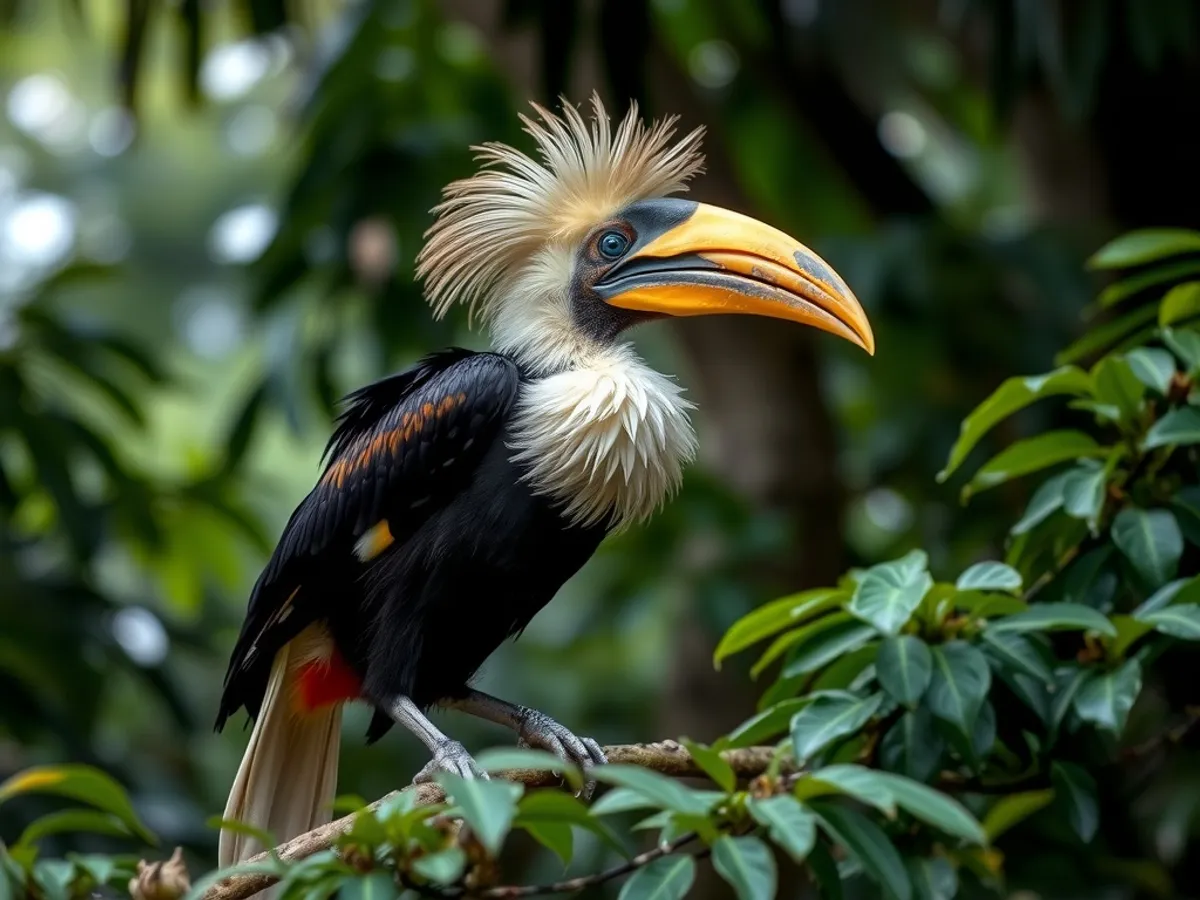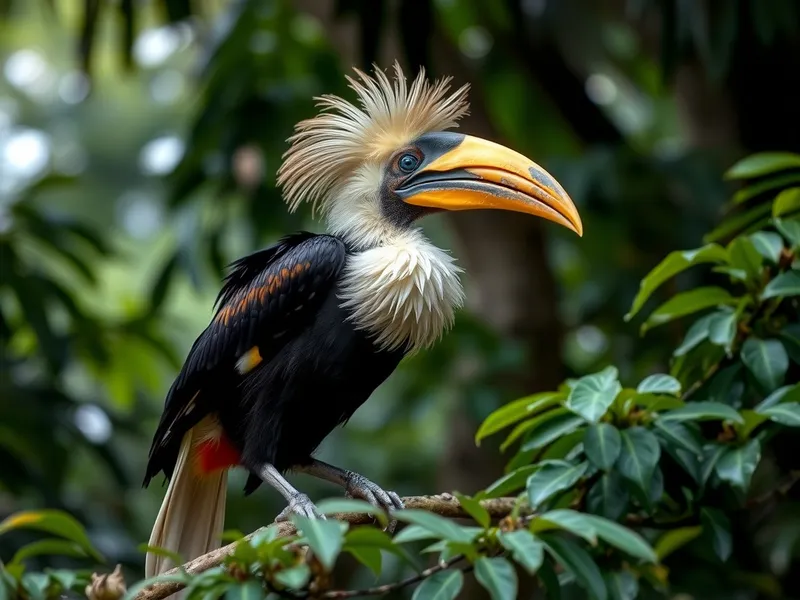
Wreathed Hornbill
Rhyticeros undulatus

Meet the Wreathed Hornbill
The Wreathed Hornbill is a striking large bird native to the forests of Southeast Asia, recognized by its impressive curved bill and prominent casque. Its plumage is mainly black with a white tail, and males have a yellow throat pouch while females display a blue one. The name 'wreathed' refers to the dark ridges or 'wreaths' on the base of its bill. These hornbills are highly arboreal and play a vital role in seed dispersal within their ecosystem. Their deep, echoing calls can often be heard resounding through the dense canopies they inhabit.
Classification
Bird
Habitat
Tropical and subtropical forests
Diet
Omnivore
Lifespan
35-40 years
Conservation
Vulnerable
Weight
2.0-3.7 kg
📖Fascinating Facts
Forest Guardian
Wreathed Hornbills play a crucial ecological role as primary seed dispersers for many large fruiting trees.
Distinctive Plumage
Males and females can be distinguished by the color of their throat pouch: males are yellow, while females are blue.
Unique Nesting Habit
Females are sealed inside a tree cavity with mud and fruit pulp during nesting, relying on the male to feed them and their chicks.
📋Detailed Description
The Wreathed Hornbill (Rhyticeros undulatus) is a large, sexually dimorphic hornbill species, with adults typically measuring 100–120 cm in length and weighing between 2.0–3.65 kg. The species is characterized by a long, decurved pale yellow bill topped with a prominent casque, which in mature individuals develops several dark transverse ridges or 'wreaths'—a unique feature among hornbills. Males display striking plumage with a rufous crown, white face, and upper breast, contrasted by a vivid yellow, featherless throat pouch edged with a diagnostic blue-black bar. Females are slightly smaller, with all-black plumage and a blue throat pouch. Both sexes have a white tail and bare orbital skin around the eyes. Their wings are broad and rounded, adapted for maneuvering through dense forest canopies. The species is highly arboreal, rarely descending to the ground, and is known for its powerful, direct flight interspersed with glides. Wreathed Hornbills possess strong, syndactyl feet for grasping branches and manipulating food. Their deep, resonant calls can carry over long distances, facilitating communication in dense forests. The species is a keystone frugivore, playing a critical role in seed dispersal for numerous large-seeded tropical trees. Socially, they are often observed in pairs or small family groups, but may form larger flocks at fruiting trees or communal roosts.
💡 Did you know?
Despite their large size, Wreathed Hornbills are agile fliers and can glide silently through dense forest canopies.
🔬Research & Sources
Wikipedia Summary
The wreathed hornbill is an Old World tropical bird of the hornbill family Bucerotidae, also called bar-pouched wreathed hornbill due to its distinctive blue-black band on its lower throat sac. It is named after its characteristic long, curved bill that develops ridges, or wreaths, on the casque of the upper mandible in adults. Males are black with a rufous crown, a white upper breast and face, and a yellow featherless throat. Females are uniformly black with a blue throat and are slightly smaller than males.
Last Modified: 5/12/2025
🎭Behavior & Social Structure
Wreathed Hornbills are diurnal and spend the majority of their day foraging in the upper canopy, where they feed primarily on fruits, especially figs (Ficus spp.), but also consume small animals such as insects, reptiles, and occasionally small mammals and birds. Their foraging behavior is methodical, using their large bills to pluck fruit and toss it back into their throats. They are highly mobile, often traveling several kilometers daily in search of fruiting trees. Social interactions are complex; pairs maintain strong bonds through mutual preening and synchronized calling, while larger groups may gather at abundant food sources or communal roosts, sometimes numbering over 100 individuals. Territorial disputes are rare but can occur at nest sites or key feeding locations. Roosting typically occurs in tall, emergent trees, and birds return to the same roosts nightly. Vocalizations include deep, booming calls and cackles, used for mate communication and territory advertisement.
👶Reproduction & Life Cycle
Wreathed Hornbills are monogamous, forming long-term pair bonds. The breeding season varies regionally but generally coincides with the onset of the rainy season (March–June in much of their range). Nesting takes place in natural tree cavities, often high above the ground. The female seals herself inside the cavity using a mixture of mud, fruit pulp, and droppings, leaving only a narrow slit through which the male passes food. Clutch size is typically 1–3 eggs. The incubation period lasts about 28–35 days, with the female remaining sealed in the nest for up to 90 days, during which she molts her flight feathers. The male is solely responsible for provisioning the female and chicks during this period. After fledging, chicks remain dependent on their parents for several weeks as they learn to forage and navigate the canopy.
🛡️Adaptations & Survival
Wreathed Hornbills exhibit several remarkable adaptations. Their large, lightweight bills and casques are reinforced with internal struts, providing strength without excessive weight. The casque may function in acoustic resonance, sexual selection, or as a visual signal. Their syndactyl feet (two toes fused) enhance grip and agility in the canopy. The unique nesting behavior, with the female sealed inside the cavity, protects eggs and chicks from predators and environmental hazards. Their digestive system is adapted to process large quantities of fruit, and they are capable of swallowing sizeable seeds whole, which are later dispersed intact, aiding forest regeneration. Their strong pair bonds and cooperative breeding behavior enhance reproductive success in challenging environments.
🎨Cultural Significance
Wreathed Hornbills hold cultural importance in several indigenous communities within their range. In parts of Borneo and Northeast India, their casques and feathers are used in traditional ceremonial attire and headdresses, symbolizing status and bravery. The species appears in local folklore as a messenger or guardian of the forest. In some regions, hornbills are considered omens of good or bad fortune, and their presence is associated with forest health. Conservation initiatives increasingly incorporate traditional ecological knowledge and cultural values to foster local stewardship.
🔬Recent Research & Discoveries
Recent research has focused on the species' role as a keystone seed disperser, with studies demonstrating their critical contribution to the regeneration of large-seeded canopy trees. Radio-telemetry and GPS tracking have revealed extensive daily and seasonal movements, highlighting the need for landscape-level conservation. Ongoing studies are examining the impacts of forest fragmentation on breeding success and genetic diversity. Conservationists are also piloting artificial nest boxes to mitigate the loss of natural cavities. The species' vocalizations and social behaviors are subjects of bioacoustic and ethological research, providing insights into hornbill communication and social structure.
🎥Wildlife Videos

Yunnan Dehong Series | Episode 7: A fresh start
The wreathed hornbill's breeding season takes place in a solitary tree hole. These hollows do not appear on their own.
CGTN Nature

Yunnan Dehong Series | Episode 5: Woodland struggles
Summer is here. For the great hornbill, this is the busiest time of the year. Over the months to come, hornbill couples will devote all ...
CGTN Nature

Yunnan Dehong Series | Episode 6: A woodland tale
The Hornbill Vale, with its remarkable biodiversity, draws wildlife shutterbugs from far and wide. For bird-watching enthusiasts, this ...
CGTN Nature

Great Hornbill parents feeding their young together | Birding in China
A huge, distinctive hornbill with a large yellow bill and casque. Black face, wings, and breast contrast with white neck, belly, and ...
SuBirds Nature Tours

Oriental Pied Hornbill & Wreathed Hornbill Feeding their mates in the nest | Birding in China
biOriental Pied Hornbill : A small black-and-white hornbill with a whitish-yellow bill and “helmet.” Primarily black, but with a white ...
SuBirds Nature Tours

Wreathed Hornbill, Tamao Mountain Wildlife Rescue Center, Phnom Tamao Zoo,
ជំរាបសួរពុកម៉ែបងប្អូនទាំងអស់គ្នា! Visit more videos by Link below=== សត្វទៀវ ...
SP-Nature
🌍Habitat Information
The Wreathed Hornbill typically inhabits Tropical and subtropical forests environments. Wreathed Hornbills have adapted to their environments with specialized features and behaviors.
Primary Habitat:
Tropical and subtropical forests
More detailed habitat information will be available soon.
🛡️Conservation Status
The Wreathed Hornbill is currently classified as Vulnerable. Conservation efforts are crucial for preserving this species for future generations.
Common Threats:
- 🏠Habitat loss and fragmentation
- 🌡️Climate change impacts
- 🎯Hunting and poaching
- 🏭Human-wildlife conflict
⚠️Threats & Conservation Challenges
The primary threats to Wreathed Hornbills are habitat loss and fragmentation due to logging, agricultural expansion, and infrastructure development across Southeast Asia. They are also targeted by hunting for their casques, meat, and as pets, particularly in parts of Indonesia and Myanmar. Nest trees are often selectively logged, reducing available breeding sites. Population declines are most severe in areas with high human encroachment. The species is classified as Vulnerable by the IUCN, with an estimated global population of 15,000–30,000 mature individuals and a decreasing trend. Conservation challenges include enforcing hunting bans, protecting large tracts of primary forest, and promoting community-based nest protection programs.
🔬Scientific Classification
Scientific Name
Rhyticeros undulatus
Classification Hierarchy
🔍 About Taxonomic Classification
Taxonomic classification is a hierarchical system used by scientists to classify and organize living organisms based on shared characteristics and evolutionary relationships.
The system moves from broad categories (Kingdom) to increasingly specific ones, with each animal's scientific name typically consisting of its Genus and species.
📝Community Notes
Share your observations and insights about the Wreathed Hornbill with our community of wildlife enthusiasts.
Join Our Community
Sign in to share your observations and connect with fellow wildlife enthusiasts.
Sign In to ContributeNo community notes yet
Be the first to share your observations about the Wreathed Hornbill!
Explore Wreathed Hornbill
Select a tab above to learn more about this amazing animal.
📸Photo Gallery
No photos available for this animal yet.
🌟Discover More Wildlife
Continue your journey of discovery with more fascinating animals from our database
